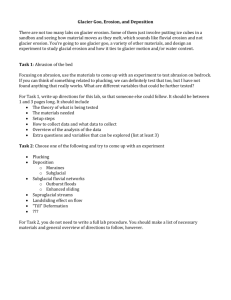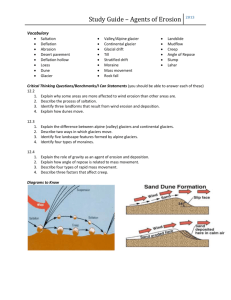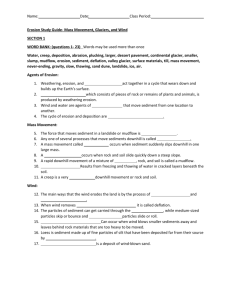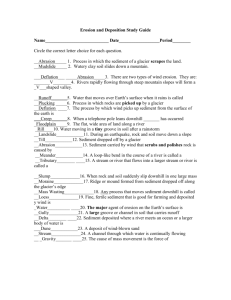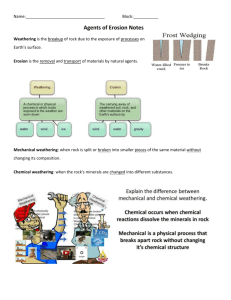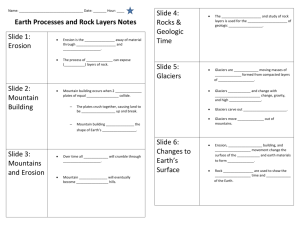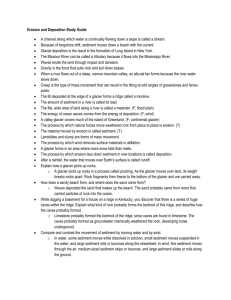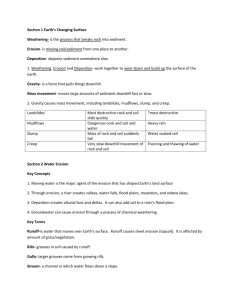Earth Science Chapter 3 Study Guide: Erosion & Weathering
advertisement
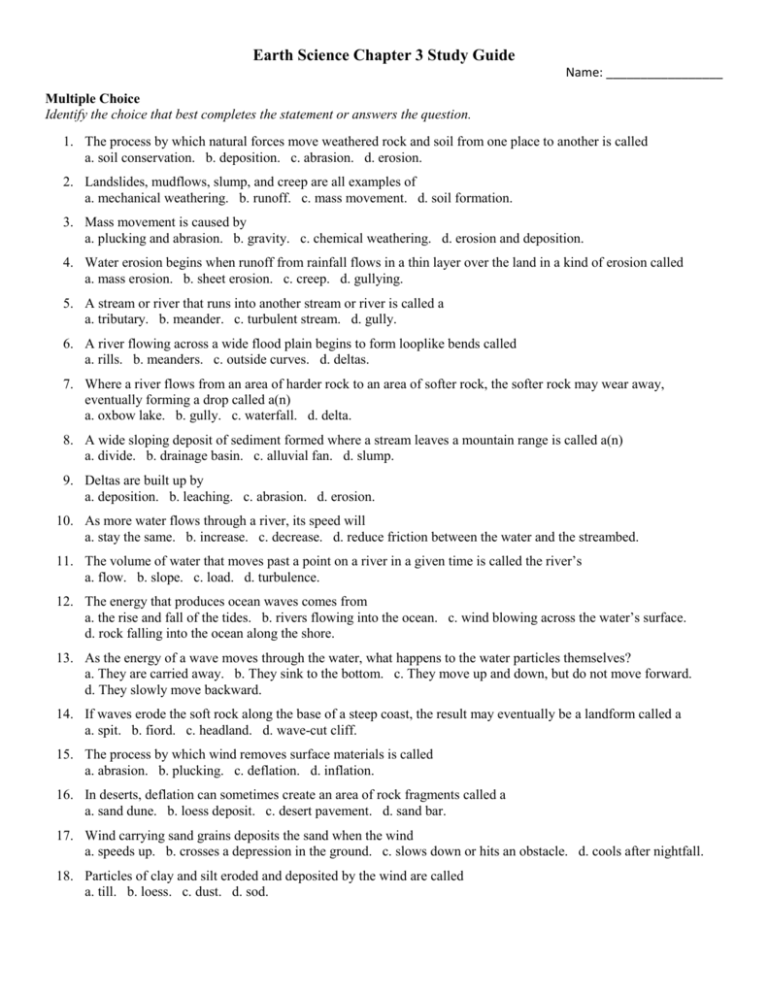
Earth Science Chapter 3 Study Guide Name: _________________ Multiple Choice Identify the choice that best completes the statement or answers the question. 1. The process by which natural forces move weathered rock and soil from one place to another is called a. soil conservation. b. deposition. c. abrasion. d. erosion. 2. Landslides, mudflows, slump, and creep are all examples of a. mechanical weathering. b. runoff. c. mass movement. d. soil formation. 3. Mass movement is caused by a. plucking and abrasion. b. gravity. c. chemical weathering. d. erosion and deposition. 4. Water erosion begins when runoff from rainfall flows in a thin layer over the land in a kind of erosion called a. mass erosion. b. sheet erosion. c. creep. d. gullying. 5. A stream or river that runs into another stream or river is called a a. tributary. b. meander. c. turbulent stream. d. gully. 6. A river flowing across a wide flood plain begins to form looplike bends called a. rills. b. meanders. c. outside curves. d. deltas. 7. Where a river flows from an area of harder rock to an area of softer rock, the softer rock may wear away, eventually forming a drop called a(n) a. oxbow lake. b. gully. c. waterfall. d. delta. 8. A wide sloping deposit of sediment formed where a stream leaves a mountain range is called a(n) a. divide. b. drainage basin. c. alluvial fan. d. slump. 9. Deltas are built up by a. deposition. b. leaching. c. abrasion. d. erosion. 10. As more water flows through a river, its speed will a. stay the same. b. increase. c. decrease. d. reduce friction between the water and the streambed. 11. The volume of water that moves past a point on a river in a given time is called the river’s a. flow. b. slope. c. load. d. turbulence. 12. The energy that produces ocean waves comes from a. the rise and fall of the tides. b. rivers flowing into the ocean. c. wind blowing across the water’s surface. d. rock falling into the ocean along the shore. 13. As the energy of a wave moves through the water, what happens to the water particles themselves? a. They are carried away. b. They sink to the bottom. c. They move up and down, but do not move forward. d. They slowly move backward. 14. If waves erode the soft rock along the base of a steep coast, the result may eventually be a landform called a a. spit. b. fiord. c. headland. d. wave-cut cliff. 15. The process by which wind removes surface materials is called a. abrasion. b. plucking. c. deflation. d. inflation. 16. In deserts, deflation can sometimes create an area of rock fragments called a a. sand dune. b. loess deposit. c. desert pavement. d. sand bar. 17. Wind carrying sand grains deposits the sand when the wind a. speeds up. b. crosses a depression in the ground. c. slows down or hits an obstacle. d. cools after nightfall. 18. Particles of clay and silt eroded and deposited by the wind are called a. till. b. loess. c. dust. d. sod. 19. What is one main difference between continental glaciers and valley glaciers? a. Continental glaciers are much larger and thicker. b. Each type of glacier is made of different materials. c. Valley glaciers cause more erosion. d. Continental glaciers never melt. 20. Glaciers can only form when a. there is an ice age. b. there is a U-shaped valley in the mountains. c. the amount of snow exceeds the amount of rain. d. more snow falls than melts. 21. The process in which rock fragments freeze to the bottom of a glacier and then are carried away when the glacier moves is called a. plucking. b. surging. c. valley widening. d. abrasion. 22. Which of the following is evidence that an area was once covered by a glacier? a. loess deposits b. V-shaped valley c. U-shaped valley d. alluvial fan 23. After the last ice age, stranded ice blocks left behind by the continental glacier melted and formed a. kettles. b. cirques. c. drumlins. d. moraines. 24. A ridge of till located at the farthest point reached by a glacier is called a a. horn. b. fiord. c. terminal moraine. d. drumlin. 25. How would a fast-flowing river be most likely to move sand-sized particles of sediment? a. It would lift them and carry them downstream. b. It would dissolve them completely in solution. c. It would roll or slide them along the streambed. d. It would deposit them on the streambed. 26. Where a coastline turns and interrupts longshore drift, sand may be deposited in a fingerlike landform called a a. spit. b. barrier beach. c. sandbar. d. headland. 27. A small depression that forms when a chunk of ice is left in glacial till is known as a(n) a. arête. b. cirque. c. fiord. d. kettle. 28. The Silver Strand Beach in California is an example of a a. barrier beach. b. sea cave. c. spit. d. wave-cut cliff. 29. The Mojave Desert’s desert pavement was created through the process known as a. abrasion. b. deflation. c. deposition. d. erosion. 30. During sheet erosion, runoff forms tiny groves in the soil called a. deltas. b. gullies. c. rills. d. streams. Modified True/False Indicate whether the statement is true or false. If false, change the identified word or phrase to make the statement true. 31. The process that lays down sediment in a new location is erosion. _________________________ 32. Creep is very slow movement of sediment down a slope. _________________________ 33. An alluvial fan may form where a stream flows out of a narrow mountain valley, slows down, and deposits sediment. _________________________ 34. As a river’s slope increases, the power of the river to cause erosion usually decreases. _________________________ 35. The stronger the wind, the larger the particles it erodes. _________________________ 36. A valley glacier spreads out over a large island or continent. _________________________ 37. Once the depth of snow and ice reaches more than 30 to 40 meters, the force of friction begins to pull a glacier downhill. _________________________ 38. In a process called plucking, the rocks dragged by glaciers produce grooves and scratches in bedrock. _________________________ 39. Many of the highest peaks in the Sierra Nevadas contain small continental glaciers. 40. A(n) stream is full of water only after a rainstorm. Completion Complete each statement. 41. Wind and water are agents of ____________________ that move sediment from one location to another. 42. The force that moves sediment in a landslide or mudflow is ____________________. 43. A mass movement called a(n) ____________________ occurs when sediment suddenly slips downhill in one large mass. 44. The major agent of erosion that shapes Earth’s land surface is moving ____________________. 45. Through erosion, rivers form ____________________, which are wide, flat areas covered by water during floods. 46. Sediment deposited where a river flows into an ocean or lake is called a(n) ____________________. 47. A streambed’s shape affects the amount of ____________________ between the water and the streambed. 48. Ocean waves contain energy that is transferred to them by ____________________ moving across the surface. 49. The two processes by which waves erode the land are impact and ____________________. 50. The main way that the wind erodes the land is by the process of ____________________. 51. Loess is sediment made up of fine particles of silt that have been deposited far from their source by ____________________. 52. A kind of glacier called a(n) ____________________ forms when ice and snow build up in a mountain valley. 53. The times in the past when continental glaciers covered large parts of Earth’s land surface were the ____________________. 54. The mixture of sediments deposited directly by a glacier is called ____________________. 55. The process in which a glacier loosens and picks up rock as it moves is called ____________________. 56. As the water in a river moves downstream, the water’s ____________________ does work by moving sediment. 57. Boulders can become smaller as they are moved down a stream bed. This is an example of the process of ____________________, the wearing away of rock by grinding action. 58. As waves repeatedly hit a beach, some of the beach sediment moves down the beach with the current, in a process called ____________________. 59. A(n) _________________ results in a valley glacier flowing up to 6 kilometers per year. 60. _____________________, which consists of pieces of rock or remains of plants and animals, is produced by weathering and erosion.

